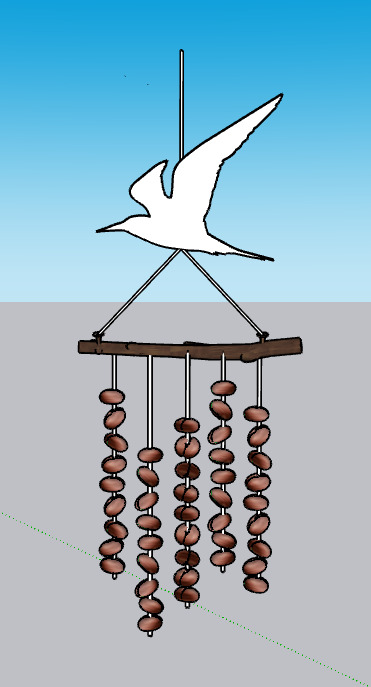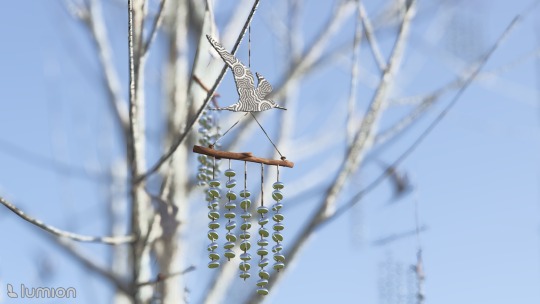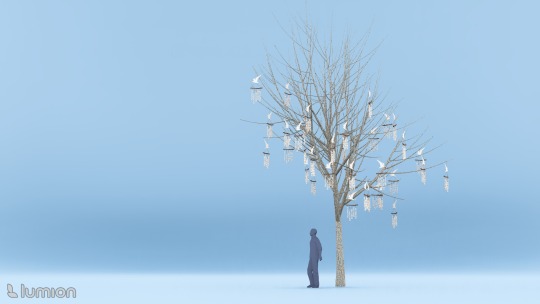This is my creative process for The Chimes of Life, a project inspired by Brisbane’s bird species, created for my KVB222 course.
Don't wanna be here? Send us removal request.
Text
Blog Post 9.
Digital Module
This high-fidelity module captures the full scope of the project, including the tree, accurate scale, and proven feasibility. Using SketchUp for modeling and Lumion for rendering, I was able to bring the concept to life in a way that demonstrates its practicality and visual impact. I’m very pleased with the result, as it effectively presents the complete vision of the project.




0 notes
Text
Blog Post 8.
Physical Module The initial plan was to use rocks for the chimes, but due to safety concerns, I decided to explore other materials. My tutor suggested using seed pods, which would enhance the natural theme and be much safer. For the prototype, however, I experimented with clay to test the concept. The module is constructed with 9mm wood dowels, MDF board, cotton twine, and clay. Once the clay dried, it produced a pleasant tone, but unfortunately, it was too heavy to move freely with the wind. Despite this, the module effectively translates the overall idea and helped guide the design process.

0 notes
Text
Blog Post 7.
Research into the birds.
While researching the local wildlife at Victoria Park, I initially came across eBirdwatcher.com, which lists 38 bird species observed in the park. However, knowing that user-generated data can sometimes lack accuracy, I searched for a more reliable source. That’s when I found the WetlandInfo website by the Queensland government, which provides comprehensive data on bird species across Queensland.
According to WetlandInfo, there are a total of 482 bird species in Queensland, with 32 listed as vulnerable or endangered. Going through the list, I was struck by the uniqueness of each species—and saddened by the realization that we could lose them. That's when I decided to dedicate this artwork to those 32 species of birds. Each silo will be topped by the silhouette of these birds. Total of 64 windchimes both male and female, represent life cycle.
In Aboriginal culture, trees hold deep significance as they are seen as living beings that connect the earth, sky, and ancestral spirits. Trees represent continuity, knowledge, and life, embodying the cycles of birth, growth, and renewal. If we borrow this context the artwork will utilize the cultural symbolism, the tree, to encourage awareness of these unique bird species.

0 notes
Text
Blog Post 6.
Early Prototype
As I developed the concept, I realized I wanted to honor Aboriginal traditions more deeply within the project. While my initial idea drew heavily from Mongolian shamanistic practices, I felt it was important not to overshadow the cultural significance of the land on which the installation would stand. So, I decided to step back from the Mongolian inspiration and instead explore ways to include respectful elements from Aboriginal culture. This approach allowed me to focus on creating an installation that resonates with the local history and spiritual connections to nature within the Aboriginal tradition, without appropriating cultural symbols. My initial Idea was to make the chimes out of Aluminum or Brass (Recycled Steel) because those materials are heavily used in Mongolian tradition but with the recent development I shifted to use natural materials like Stone, wood, and twine.


0 notes
Text
Blog Post 5.
Artist Research
I looked up artists that have utilized chimes or sound before to draw inspiration and avoid plagiarism
Singing Ringing Tree.
Chimecco
Japanese Windbell Tree



0 notes
Text
Blog Post 4.
Initial Idea 2.
I want the art to not only represent my culture but to represent the local culture as well. Top of each chimes there could be silhouettes of all the different types of birds of Victoria park.


0 notes
Text
Blog Post 3.
Initial Inspiration
Growing up in an Asian household, I grew familiar with the sound of chimes and bells. In Mongolian shamanism, the sounds of chimes and bells hold a special place, often resonating through ceremonies. The artistic elements within this tradition are beautifully expressive, and I wondered—what if I drew inspiration from that?
There's a tree in Mongolia called ‘Eej Mod / Mother Tree’ . It is a highly spiritual tree that people go to have religious ceremonies. The tree is wrapped in thousands of colorful cloths named ‘Khadag’ it looks beautiful though it doesn’t look very healthy to the tree.
So. What if there were a hundred chimes tied to the tree. Each chime has a different colored cloth hanging off of it.

2 notes
·
View notes
Text
Blog Post 2.
Initial Idea
As I stood there, I noticed how quiet, calm, and peaceful the area felt. An idea started to form. Recently, in my Creative Enterprise Studios 2 class, I’d watched a video about an installation called the Zadar Sea Organ. Built along the coast, this installation produces a beautiful melody whenever waves hit the shore, transforming the natural rhythm of the sea into sound.
Remembering that, I wondered: what if, instead of waves, it was the wind creating sound—like a chime?


0 notes
Text
Blog Post 1.
Location
Victoria Park seemed like a fitting location for the Green Heart Fair. The park offers a variety of distinct spots shaped both by its history and by human landscaping efforts. One area that stood out was the “Wall of Trees”—a row of around a dozen tall trees that seemed like a practical option for coming up with a creative concept.
While walking along the “Wall of Trees,” I noticed a single, tall, leafless tree at the end that caught my attention. I imagine others might use the main row for their installations, so this tree at the end could serve as a quieter focal point, potentially drawing a bit of interest from visitors.


0 notes

